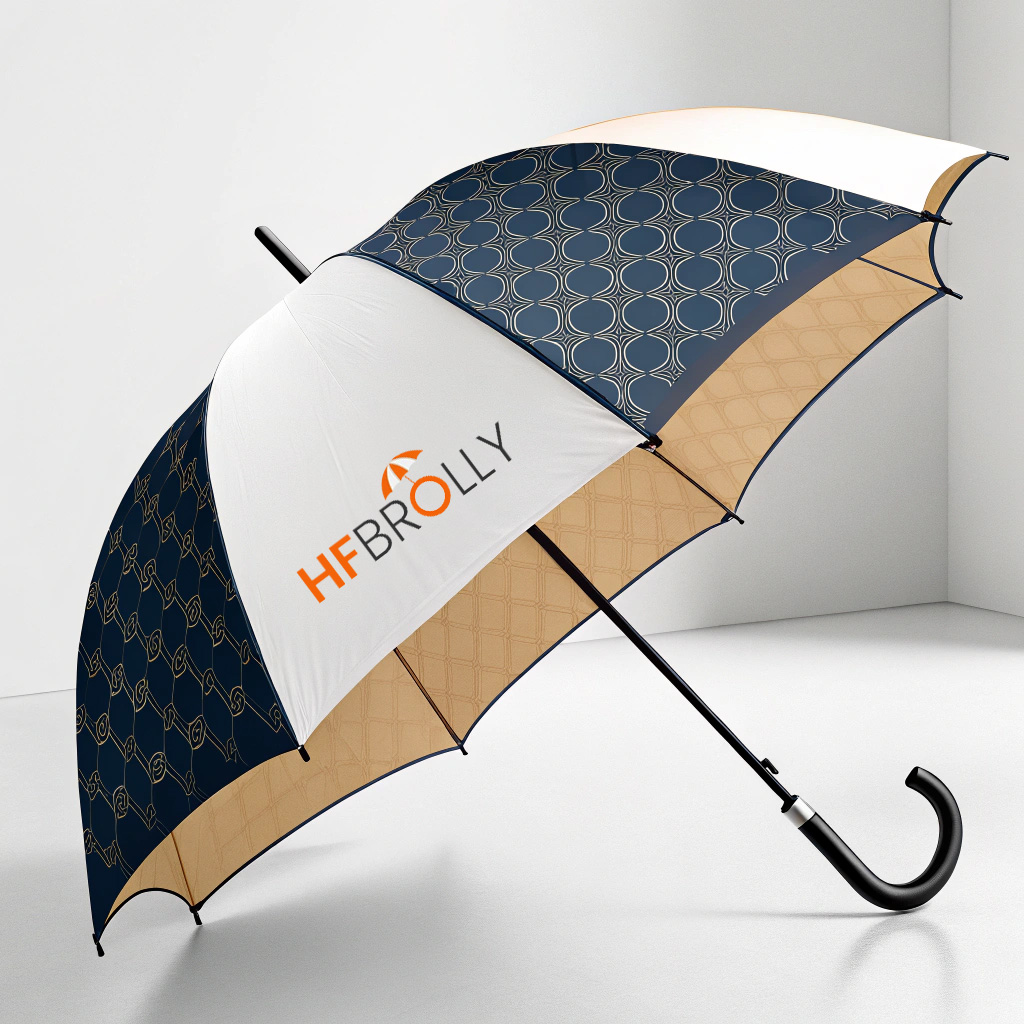
Branding an umbrella might seem straightforward: send over your logo, choose a colour, and off it goes. But in practice, getting the branding right takes more than that, especially if you want your umbrellas to look sharp, consistent, and professional.
In custom umbrella manufacturing, even small misunderstandings around branding can lead to frustrating results. Logos printed off-centre. Colours slightly off. Placement not quite where you expected. It’s rarely intentional. More often, it’s a lack of clarity upfront.
Here are five things to align on before your umbrellas go into production, plus how HFBROLLY guides buyers through each step to avoid surprises later on.
1. Logo File Format — “Can you send a vector?”
Let’s start with the basics: your logo file. Most branding mistakes begin here, because the wrong file can limit print quality from the start.
What your supplier needs:
- A vector file, ideally in AI, EPS, or PDF format.
- This allows the logo to be resized without losing clarity.
- Include any fonts or outlines converted to shapes to avoid issues.
Many buyers send PNGs or JPEGs, but those are raster files… they can look fine on screen but become blurry when enlarged for printing.
At HFBROLLY, we check your files as soon as you send them. If the format isn’t right, we’ll ask before doing anything or help convert what we can. We don’t move forward until the logo is print-ready.
2. Printing Position — “Where exactly will the logo go?”
Umbrellas have multiple panels, seams, and curved surfaces. So when it comes to branding, “put it on the canopy” isn’t quite enough.
You’ll need to agree on:
- Which panel(s) the logo will appear on
- Orientation: right way up when open? Or when held closed?
- Centre, left, right, or edge-aligned?
- Distance from seams or edges (some methods require a margin)
This is where things often go wrong. Without a detailed mockup or visual confirmation, you may imagine the logo in one place, but the factory puts it somewhere else perfectly aligned to their system, just not to your expectations.
A common misunderstanding? Buyers assuming the logo will be centred, but the factory avoids the centre due to seam interference or auto-fold mechanisms.
“One of the biggest surprises clients face is seeing their logo printed too close to the tip or the edge. They expected a central placement but didn’t confirm how the factory interprets ‘centre’.”
HFBROLLY avoids this issue by providing a visual mockup for every custom print. You’ll see exactly where your logo will sit on the umbrella panel at scale before approving production. You can request changes, adjust alignment, or try variations before making a final call.
3. Colour Matching — “Let’s get the shade right.”
Getting your logo colour right isn’t just about sending over an image and hoping for the best. Umbrella fabrics vary in texture, gloss, and absorbency and that affects how ink appears once printed.
To avoid unpleasant surprises, align on:
- Pantone (PMS) colour codes, never just “red” or “blue”
- Whether you’re printing on fabric or labels, as the substrate affects output
- Ink method: screen print, heat transfer, or digital as each reacts differently
- Whether the ink will appear on a coloured canopy or white background
Also, remember: the same Pantone colour can look slightly different depending on the base material. That’s why it’s crucial to not only provide Pantone codes, but also request print tests or fabric swatches when time allows.
HFBROLLY works with Pantone-coded inks and always checks fabric interaction before full production. We run internal tests to match the ink with the canopy type and flag any potential deviation. If needed, we’ll send you video samples or physical test prints to approve.
We treat colour seriously because we know your branding depends on it.
4. Logo Size and Coverage — “Big enough to notice — but not distorted.”
Sometimes buyers want to make a bold statement: a large logo, covering as much of the panel as possible. Other times, it’s a more subtle, minimal approach.
Either way, there’s a limit to how far you can go.
Due to the shape and seams of umbrella panels, logo coverage has natural constraints. This is where scaling and positioning need to be carefully discussed. If you want:
- A wraparound design, check how it behaves across multiple panels
- A full-panel print, confirm if your design fits within safe zones
- A multi-location logo (e.g., one inside and one outside), confirm costs and alignment for both
It’s also important to talk about proportional scaling. If your logo is tall and narrow, how will it sit within a triangular umbrella panel? Should it be rotated? Reduced? Cropped?
At HFBROLLY, our design team creates custom layouts based on your brand guidelines, panel shape, and umbrella style. We don’t just stretch your logo to fit.
You’ll get a clear digital mockup with exact dimensions. And if something looks off? We’ll suggest refinements before any fabric gets near a printer.
5. Print Method and Surface Compatibility — “What kind of print are we talking about?”
Not all print methods behave the same, and the one you choose should depend on both your design and the umbrella’s construction.
Here are the most common printing options:
- Screen printing – best for solid colours and simple designs
- Digital transfer – ideal for detailed or multi-colour artwork
- Sublimation – great for all-over prints on white canopies
- Heat transfer – used for small logos, labels, or specialty placements
But there are limitations. For example:
- Metallic inks may not cure properly on some fabrics
- Fine lines or gradients can blur in screen printing
- Sublimation only works well on specific materials
- Some methods may not last as long in harsh weather
And if we think a print method could result in disappointing visuals or durability? We’ll tell you that, too.

HFBROLLY’s Branding Confirmation Process
Branding isn’t a step we rush, it’s one of the most important parts of your custom umbrella.
Here’s how we help buyers avoid branding mistakes from the start:
- Artwork check-up
We review your logo files for format, clarity, scalability, and Pantone accuracy. If something’s off, we’ll request a better version or help adjust it for print. - Mockups and positioning review
Before printing, we send a visual layout showing logo placement, size, and panel orientation. You’ll see exactly what your umbrella will look like when opened. - Print testing and colour confirmation
For large or sensitive orders, we run print tests on the actual canopy material. We check ink behaviour, colour matching, and durability. - Sign-off before production
Nothing moves to bulk production without your approval. If we spot an issue, like a logo too close to a seam or colour shift, we fix it first. - QC during and after printing
Our production team checks every print batch for alignment, clarity, and colour consistency, not just a handful at the end.
We do this not just to protect our output, but to protect your brand.
Common Branding Mistakes — And How to Avoid Them
To wrap up, here are some of the most common branding issues we’ve seen (or been asked to fix after others made them):
- Logo printed too close to the edge, cut off by seams
- Wrong shade of corporate colour, due to no Pantone code
- Logo looks pixelated or blurry, from a low-res file
- Print too small or too big, due to miscommunication on scaling
- Print method chosen for price, not visual outcome resulting in poor durability or faded logos
- Wrong panel printed, due to unclear mockup or lack of confirmation
These are all preventable. But only if you and your supplier talk clearly from the start.
Final Thoughts
At HF BROLLY, we make this process collaborative. You don’t need to know everything about umbrella construction or printing… that’s our job. You just need to share your vision and your assets, and we’ll walk you through the rest.
Send us your logo and we’ll guide you through the best placement and print type.


